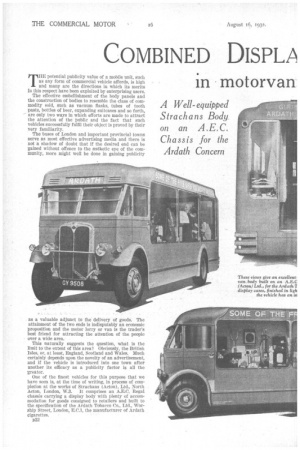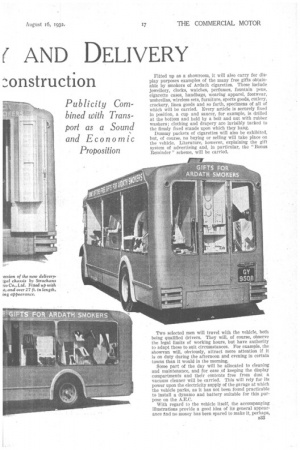COMBINED DISPLA ( AND DELIVERY
Page 50

Page 51

Page 52

If you've noticed an error in this article please click here to report it so we can fix it.
in motorvan :onstruction
THE potential publicity value of a mobile unit, such as any form of commercial vehicle affords, is high and many are the directions in which its merits In this respect have been exploited by enterprising users.
The effective embellishment of the body panels and the construction of bodies to resemble the class of commodity sold, such as vacuum flasks, tubes of tooth paste, bottles of beer, expanding suitcases and so forth, are only two ways in which efforts are made to attract the attention of the Public and the fact that such vehicles successfully fulfil their object is proved by their very familiarity.
The buses of London and important provincial towns serve as most effective advertising media and there is not a shadow of doubt that if the desired end can be gained without offence to the mstketic eye of the community, more might well be done in gaining publicity " as a valuable adjunct to the delivery of goods. The attainment of the two ends is indisputably an economic proposition and the motor lorry or van is the trader's best friend for attracting the attention of the people over a wide area.
This naturally suggests the question, what is the limit to the extent of this area? Obviously, the British Isles, or, at least, England, Scotland and Wales. Much certainly depends upon the novelty of an advertisement, and if the vehicle is introduced into one town after another its efficacy as a publicity factor is all the greater.
One of the finest vehicles for this purpose that we have seen is, at the time of writing, in process of completion at the works of Strachans (Acton), Ltd., North Acton, London, W.3. It comprises an A.E.C. Regal chassis carrying a display body with plenty of accommodation for goods consigned to retailers and built to the specification of the Ardath Tobacco Co., Ltd., Worship Street, London, E.C.1, the manufacturer of Ardath cigarettes.
B32 Fitted up as a showroom, it will also carry for display purposes examples of the many free gifts obtainable by smokers of Ardath cigarettes. These include jewellery, clocks, watches, perfumes, fountain pens, cigarette cases, handbags, wearing apparel, footwear, umbrellas, wireless sets, furniture, sports goods, cutlery, crockery, linen goods and so forth, specimens of all of which will be carried. Every article is securely fixed in position, a cup and saucer, for example, is drilled at the bottom and held by a bolt and nut with rubber washers; clothing and drapery are invisibly tacked to the firmly fixed stands upon which they hang.
Dummy packets of cigarettes will also be exhibited, but, of course, no buying or selling will take place on the vehicle. Literature, however, explaining the gift system of advertising and, in particular, the "Bonus Reminder" scheme, will be carried.
Two selected men will travel with the vehicle, both being qualified drivers. They will, of course, observe the legal limits of working hours, but have authority to adapt these to suit circumstances. For example, the showvan will, obviously, attract more attention if it is on duty during the afternoon and evening in certain towns than it would in the morning.
Some part of the day will be allocated to cleaning and maintenance, and for ease of keeping the display compartments and their contents free from dust a vacuum cleaner will be carried. This will rely for its power upon the electricity supply of the garage at which the vehicle parks, as it has not been found practicable to install a dynamo and battery suitable for this purpose on the A.E.C.•
With regard to the vehicle itself, the accompanying illustrations provide a good idea of its general appearance and no money has been spared to make it, perhaps, B33 the finest of its kind in existence. The A.E.C. Regal forward-control chassis carrying the attractive Strachans showvan body affords a splendid example of British workmanship.
Finished in Cambridge blue with chromium-plated fittings and window frames and a stainless steel bumper bar running the full length of the body, it has three large i-in. plate-glass windows on each side, each of which is detachable in its frame by the removal of 26 bolts, and a smaller window in the rear door.
A centre gangway separates the two display bays which run the full length of the body, and communicates with the cab by a sliding door. Beneath the showcases ample accommodation for packages for delivery is provided.
The interior is finished entirely in cream and illumination at night is effected by no fewer than 21 36-watt roof lights in each long display bay, staggered and situated in double reflectors to distribute the light evenly. Further lamps are fitted in the rear showcase and in the gangway. The bulbs are placed so as to be out of the range of vision of persons outside the windows,.
To provide the current required for this lavish illumination, an auxiliary dynamo is driven by a belt from the back of the gearbox, and additional accumulators are installed and accommodated inside the body under the front ends of the showcases in trays arranged to slide into the gangway for topping-up purposes. The switches for the interior lamps and a master switch for tire complete installation, together with fuse boxes, etc., are mounted above the driver's head, and the unit is so comprehensive as to suggest the switchboard of a small power station.
In view of the heat generated by the many electric lamps, great attention has been paid to ventilation. An air passage is formed between the two parts of the double roof. Three louvres at the front of the cab feed this duct and eight Ashanco ventilators combine to extract air from the interior. Two glazed hinged vents provide additional ventilation and illumination by daylight for the gangway.
The seats for the driver and attendant, situated one on each side of the engine, are upholstered with pneumatic cushions. The three-piece metal-framed windscreen is of Fin. Triplex safety glass, as is the winding-type drop window of each door. A bluetinted sun vizor is fitted over the screen for the full width of the cab. Two British Berkshire electric windscreen wipers are installed. The doors are hung on concealed hinges and have recessed exterior handles. All four doors are fitted with private locks.
At front and rear, in the places usually occupied by destination indicators, are sign panels bearing the name Ardath, and similar panels run the full length of the body above the windows. These have necessitated some skilful panel beating in order that their horizontal lines shall merge gracefully with the rounded roof panels at the front and rear. Incidentally, the panelling of the body is entirely of aluminium.
The equipment in the usual sense of the word consists, over and above the customary items, of a pair of electric direction-indicator arms at each side of the windscreen and a stoplight.
A few of the principal dimensions are of interest. The overall length of the vehicle is 27 ft. 6 ins., the height 9 ft. 2 ins., and the width 7 ft. 4 ins. The display bays are each 22 ft. 11i ins, long and the main windows are 6 ft. 9 ins. by 4 ft. The widths of the main show bays and the centre gangway are 2 ft. 7 ins. and 2 ft. Oi in. respectively. The windows in the rear are 4 ft. deep by 1 ft. 6.1 ins. wide.
Apart from its displayed contents, the vehicle is well calculated to attract the attention of the public on its intrinsic merits and by reason of its distinguished appearance, and once interest is thus aroused the pleasing nature of the array of articles within the long display bays is bound to have its effect.




































































































